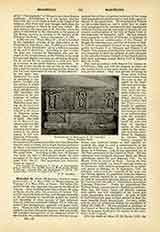

Maphrian. —The Syriac word mafriano signifies one who fructifies, a consecrator. It is used to designate the prelate who holds the second rank after the patriarch among the Jacobite Syrians. This ecclesiastical dignity goes back certainly to the seventh century and perhaps to the closing years of the sixth. When the theological school of the Persians at Edessa had been closed, first by Nonnus, successor of Ibas (457), and definitively by the Monophysite, Cyrus (489), Nestorianism triumphed in the Empire of the Sassanides. The few Persian Monophysites, like Xenaias (Philoxenus) of Tahal, were forced to go into exile. Xenaias became Bishop of Mabug (Hieropolis). In Persia, the town of Tagrit alone did not adopt the prevailing religion; it became the center of the Monophysite missions at the commencement of the sixth century. The energetic James Baradieus ordained for the Persians a bishop, Ahudenuneh, who died a martyr in 575. But the efforts of the monk Maruthas were to be crowned with greater success. At one time from the monastery of Mar Mattai (near Nineveh), at another from Tagrit itself, he undertook fruitful missionary work among the Arabs and throughout the valley of the Tigris. He relied on the influence of Chosroes II’s physician, Gabriel de Shiggar, who had completely won the confidence of the Christian queen, Shirin.
From time to time the Persian armies, which invaded the Roman territories so often at this period, would bring back a multitude of captives, Byzantines, Egyptians, Euphratesians or Edessans, mostly Jacobites. So in 628-9 it was judged suitable to organize the Monophysite Church in Persia. The Jacobite Patriarch of Antioch, Athanasius the Chancellor, saw that it would be necessary to grant the Syrians in the Persian Empire a large ecclesiastical autonomy. In fact one of the most serious objections raised by the Nestorians against the Monophysites was that the latter obeyed a spiritual head residing in Byzantine territory and that they were therefore inclined to become the subjects of the Emperor of Constantinople. Hence the Monophysites were frequently denounced at the Court of Seleucia as conspirators favoring the Romans. The Sassanides would then become incensed and persecute the Jacobites. Athanasius moreover knew certain canons which prescribed that the head of the “Oriental” Christians, namely the Persians, was alone entitled to consecrate “Oriental” bishops, and he was aware that these canons dated back to the very beginning of the Syrian Churches. He decided that the metropolitans of Tagrit, when ordained by him, would become autonomous and be sole rulers of the Monophysite churches in Persia. Maruthas had a dozen bishops subject to him. The fall of the Sassanide Empire which soon occurred did not change this arrangement. The Metropolitan of Tagrit received at a time which cannot be definitely fixed the title of “Mafriano”
The relations of the maphrian and the Jacobite Patriarch of Antioch were, despite several schisms, maintained harmoniously. In 869 it was decided that just as the patriarch consecrated the maphrian so the consecration of a new patriarch would be reserved to the maphrian. Within their own circumscriptions the maphrians had often disputes with the metropolitan of the monastery of Mar Mattai (near Nineveh) who was jealous of the preponderating influence of Tagrit. In 1089 the churches of that town having been destroyed by the Mussulmans, the maphrians abandoned it and settled in Mosul. From A.D. 1155 they generally resided at Mar Mattai while retaining an immediate jurisdiction over Tagrit and Nineveh. The only maphrian worthy of being specially mentioned is the celebrated Gregory Abulfaradj, surnamed Bar Hebraeus (q.v.) (d. 1286), the most highly cultured man of his age. There has been preserved a. history by him of his predecessors. This work was continued by his brother, and later by unscholarly annalists, and stops in the fifteenth century (1496). For a long time past the Jacobite Christians of the valley of the Tigris have seriously decreased in numbers. The title of maphrian still exists, but the office has lost all its importance and dignity.
J. LABOURT

